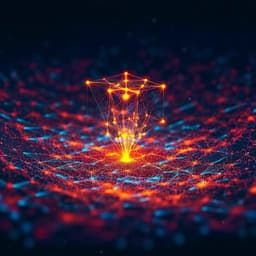
Engineering and Technology
Machine learning-enabled forward prediction and inverse design of 4D-printed active plates
X. Sun, L. Yue, et al.
This innovative research, conducted by Xiaohao Sun and colleagues, introduces a cutting-edge machine learning approach to design active composite plates capable of 3D shape changes, optimizing material distribution for complex target shapes with high efficiency.
~3 min • Beginner • English
Introduction
Active composites (ACs) are multi-material systems that exhibit programmed shape changes under external stimuli (e.g., heat, light, water, magnetic fields). Realizing target 3D shapes from flat, voxelated plates via multimaterial 4D printing requires determining an optimal spatial distribution of active and passive voxels, which is a high-dimensional, highly nonconvex inverse problem. Traditional topology optimization faces gradient derivation challenges and nonlinearity, whereas FE-driven evolutionary algorithms are computationally prohibitive due to massive forward solves. Moreover, for 2D plates with 3D deformations, the design space explodes (e.g., 15×15×2 binary voxels → 2^450 possibilities), and mapping from voxel distributions to large-deflection shapes is complex. The study aims to develop an accurate, fast, and generalizable ML-enabled forward model and integrate it with efficient optimization (GD and EA) within a global–subdomain strategy to achieve inverse voxel-level designs for diverse target shapes, including irregular and non-developable surfaces, suitable for 4D printing.
Literature Review
Prior efforts include gradient-based topology optimization for ACs and soft actuators, which can struggle with complex nonlinearities and gradient derivations, and FE-based evolutionary algorithms for active composites and structural problems, which suffer from high computational cost due to many FE evaluations. Geometric approaches leverage conformal or metric mapping to prescribe Gaussian curvature and design isotropic/anisotropic expansion fields to target surfaces. While successful for some classes (e.g., spherical/saddle), such methods cannot uniquely specify isometric states (e.g., developable surfaces) and typically neglect bending energy, limiting accuracy for finite-thickness sheets; thus they often serve as initial guesses requiring mechanics-based refinements. Other system-specific strategies (nematic sheets, origami/kirigami, lattices, buckling mesosurfaces, inflatables) demonstrate surface design capabilities but lack a universal, efficient voxel-level design method compatible with 4D printing. Recent ML applications in materials/mechanics (e.g., property optimization, metamaterials, soft robotics) show promise; limited work addresses ML-based shape-change design, and prior beam-level (1D) results do not readily generalize to 2D plates with 3D deformation due to increased complexity and design space.
Methodology
Finite element data generation: Abaqus FE simulations model a 40×40×1 mm plate meshed into 45×45×4 C3D8H elements. Both phases are incompressible neo-Hookean with identical modulus; actuation is modeled via thermal expansion mismatch (α_active=0.001, α_passive=0) under ΔT=50 °C, yielding eigenstrain 0.05 in active voxels. Voxel assignments use a 15×15×2 binary grid; each voxel maps to (45/Nx)×(45/Ny)×(15/Nz) elements. Self-contact is neglected. Boundary conditions (BCs): original BCs (clamping two opposite corners and tying out-of-plane corner displacements) enable symmetry-based augmentation; data are later converted to “converted BCs,” mimicking a corner-clamped but overall freer deformation that induces spatially sequential dependency beneficial for learning. Dataset: 56,250 designs (31,250 fully random; 25,000 “island” patterns with connected domains) are simulated under original BCs; via flips/transposes and symmetry rules, data are augmented 16×, then converted to the converted BCs, producing 900,000 (M,S) pairs. Training/validation split is 0.9/0.1. The island set tends to produce larger displacements (mean max displacement ≈33.0 mm) than fully random (≈8.4 mm). Machine-learning forward model: A deep ResNet-based CNN maps voxel distribution M to the actuated shape S (grid of 16×16 sampling points with x,y,z). Loss is SSE of coordinates. Architectural exploration shows ResNet avoids degradation in deep networks and outperforms plain CNN and GCN; best performance with ResNet-51. Separate networks trained for (x,y) jointly and for z improve accuracy. Data normalized via z-score; training uses Adam with decaying learning rate, mini-batch 512, implemented in MATLAB; training ~10 h on NVIDIA Tesla V100. Symmetry-ensemble averaging (transpose and flip-Z transforms) further improves z-prediction when used for final evaluation. Forward performance benchmarking (single CPU core + GPU): 1000 predictions take ~3.6 s with ML versus 11–28 h with FE. Inverse design: A global–subdomain strategy first optimizes all voxels, then iteratively refines subdomains comprising pixels with the largest local shape errors; each in-plane pixel corresponds to Nz voxels through thickness. Two optimizers are used: ML-GD (gradient-based) and ML-EA (gradient-free). ML-GD: Uses the differentiable ML forward model and automatic differentiation (AD) to compute exact gradients of the mean squared error (or distance-weighted variant), optimized with Adam over up to 1000 generations; continuous design variables are rounded to binary after optimization. ML-EA: Population-based integer optimization (population size 2000). Loss is a weighted MSE: during global optimization, weights w_ij=1/(i+j+1) bias improvements from fixed to free boundaries; subdomain optimization uses uniform weights w_ij=1. Global ML-EA runs 100 generations; subdomain ML-EA runs 5 generations; selection, mutation, and crossover maintain binary constraints. Target shapes: Three classes are considered. (i) FE-derived targets from intuitive/random voxel patterns allow validation against physically attainable, smooth shapes. (ii) Algorithmically generated targets defined via parametric z(u,v) functions sampled on a 16×16 grid, then scaled to approximate attainable edges; includes developable (bowed, nonuniform bending) and non-developable (twisted parabolic) surfaces. (iii) Irregular shapes (e.g., crumpled paper scan, surgical mask patch). For irregular targets, a patch representation and a normal distance-based loss are introduced: distances from achieved grid points to target surface patches are minimized, alleviating issues with unattainable boundaries or irregular point spacing. Experimental validation: Optimal voxel designs are fabricated via grayscale DLP (g-DLP) 4D printing using a resin system with volatile/nonvolatile components to induce differential shrinkage upon heating; grayscale modulates degree of conversion to realize active/passive phases. Post-processing involves heating and UV post-cure. Additional material systems and a smaller-scale plate validate generality. Differences between experimental material properties and FE assumptions are compensated by adjusting print dimensions via an analytical curvature model without retraining.
Key Findings
- High-fidelity forward prediction: ResNet-51 with converted BCs and split networks for (x,y) and z achieves R^2>0.999 for (x,y) and R^2=0.995 for z on 180,000 validation shapes (256 points each); symmetry-ensemble improves z to R^2=0.999.
- Speedup: 1000 predictions require ~3.6 s with ML vs 11 h (fully random) to 28 h (island) with FE on a single CPU core + GPU.
- Inverse design efficiency: ML-GD achieves optimal designs in ~3 min (1000 generations). ML-EA global step ~12 min (100 generations, ~200,000 evaluations); subdomain ML-EA ~0.6 min (5 generations). Estimated FE-EA for similar tasks would take ~2200–5600 h; FE-GD ~11–28 h (excluding gradient computation).
- Global–subdomain strategy improves accuracy by focusing refinement on high-error regions (often free corners), consistent with spatially sequential dependency under converted BCs; distance-weighted loss benefits global EA.
- Robust optimization across algorithms: ML-GD and ML-EA yield comparable quality overall; ML-GD can be sensitive to initialization but still achieves satisfactory solutions from varied starts (all-passive, all-active, neutral, random).
- Diverse targets achieved: Optimal designs obtained for FE-derived, algorithmic (developable and non-developable) and irregular targets. Experimental 4D-printed plates closely match targets, including a twisted parabolic surface and irregular shapes (crumpled paper, surgical mask patch). Generalization demonstrated across different material systems and a reduced length scale.
- Dataset and model scale: 56,250 FE simulations augmented 16× to 900,000 samples enable training; island patterns contribute larger deformations, enriching data diversity.
Discussion
The study addresses the central inverse design challenge for 4D-printed active plates—mapping from a massive voxel design space to 3D shapes and finding voxel patterns that realize desired targets—by combining an accurate, fast ML forward model with optimization (GD and EA) in a global–subdomain framework. Converted boundary conditions, by introducing spatially sequential dependency, facilitate learning and improve both ML prediction and optimization behavior. The ML forward model not only accelerates evaluations but also enables exact gradients via AD, overcoming difficulties of gradient derivation in traditional topology optimization under nonlinear mechanics. ML-driven EA can explore regions of the design space infeasible for FE-driven searches due to time constraints. The approach successfully realizes both developable and non-developable targets and accommodates irregular, patch-defined targets using a normal distance-based loss, relaxing strict boundary/grid sampling requirements. Experimental results validate computational predictions and demonstrate applicability across materials, actuation mechanisms, and scales. Overall, the method substantially reduces design time while maintaining high fidelity, offering a reusable ML model for many inverse design tasks and suggesting a path forward for intelligent, voxel-level design-fabrication workflows in 4D printing.
Conclusion
This work introduces an ML-enabled framework for forward prediction and inverse voxel-level design of 4D-printed active composite plates. A deep ResNet forward model trained on a large FE-generated dataset achieves near-perfect prediction accuracy and provides orders-of-magnitude speedups over FE. Integrated with gradient descent (via AD) and evolutionary algorithms in a global–subdomain strategy, the framework rapidly finds optimal material distributions for a wide array of target shapes, including challenging irregular and non-developable surfaces, and is validated experimentally across multiple material systems and scales. Future directions include: scaling to larger/finer voxel grids and different initial geometries (e.g., via cutting or multi-patch assemblies), improving print fidelity at voxel boundaries through process optimization, incorporating physics-informed constraints to reduce data needs, accounting for self-contact and more realistic material behaviors in forward models, and extending to multi-phase (>2) materials to further expand design capability.
Limitations
- Training data and model scope: The ML model is trained for a specific plate size and voxelization (15×15×2) and under particular boundary conditions; transferring to different geometries or finer features may require strategies such as cutting/multi-patch composition or retraining.
- Physics simplifications: FE assumes identical moduli for phases and neglects self-contact; experimental materials differ from FE assumptions, requiring dimension adjustments to compensate.
- Printing artifacts: Grayscale DLP may produce unsmooth features at voxel boundaries due to curing variations, potentially affecting shape fidelity.
- Optimization nuances: ML-GD can be sensitive to initialization; ML prediction errors propagate into optimization, though final FE validation mitigates this.
- Data requirements and compute: Although far less than FE-EA during design, generating ~56k FE simulations and training remain nontrivial, and symmetry-averaged ML predictions increase prediction time when used.
Related Publications
Explore these studies to deepen your understanding of the subject.







